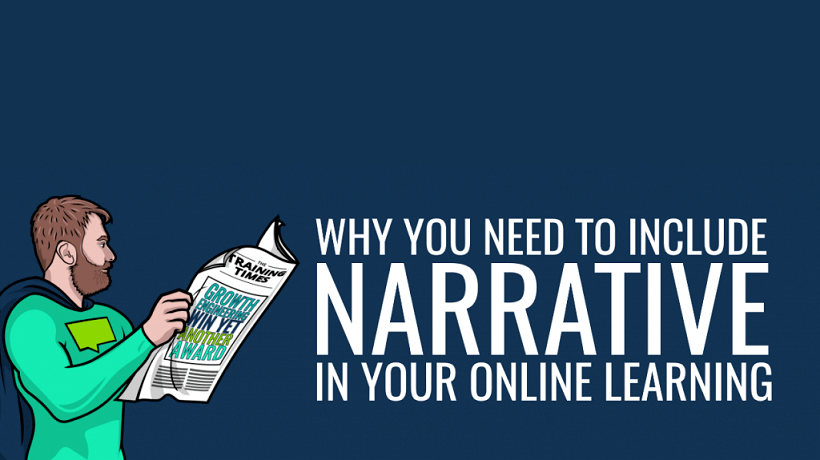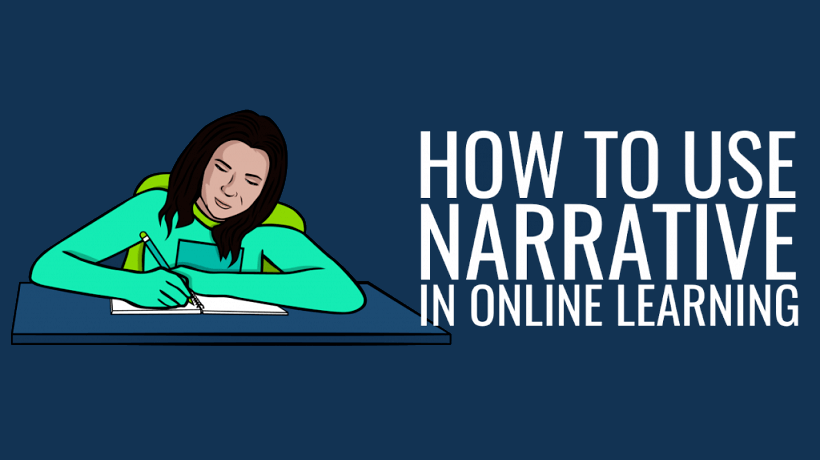What Is Interactive Narrative Learning And Why Is It A Great Way To Design eLearning?
To make eLearning fun and engaging for your learners, adopt an interactive narrative learning strategy. Popular in the gaming world, interactive narrative learning is a digital learning experience that uses storytelling to structure learning. Combining traditional narrative with visual arts and interactivity, [1] its purpose is to place the learner in the digital environment, so that they believe their choices are central to the unfolding of the story.[2] Presented with an overarching theme, learners make meaningful decisions that shape the outcome of the story. Here I highlight 6 reasons why interactive narrative is an effective eLearning strategy.
1. It Provides A Conceptual Framework To Structure Your eLearning
Like a story, the framework begins with the set-up – introducing the theme, the setting, the characters, and the role of the learner as the protagonist. At this point, the learner understands the goal of the learning, the learning objectives, and what they might expect as they navigate through the eLearning.
Once the learner’s role is established, the next part of the framework establishes the problem or challenge they must address. As learners investigate their surroundings and engage in learning activities, the story equips them with the requisite knowledge or skills to tackle the problem. The problem should be something the learner will confront in their job, because resolving it makes up the practice component of the learning experience – what you want the learner to be able to do after learning. The narrative draws the learner into the simulated problem and resolution provides them with the rich learning experience. Our learners reported that their knowledge increases as a result of the practice components in the eLearning, and this self-report was supported by their successful resolution of the problems. Finally, the denouement brings the narrative to an end, providing closure to the learner in the form of feedback.
Using a narrative framework lets the learner experience the system as a whole – adopting the role of the protagonist, seeing the problem from multiple perspectives, and unfolding the story in the direction of their choices and actions, all the while acquiring knowledge and skills to resolve the conflict in the story.
2. It Makes eLearning Contextualized
More often than not, you’ll use the learners’ work context as the setting for your story. Mirroring their environment makes learning at once familiar, relevant and accessible as well as expressing the utility of learning, which goes a long way in motivating your learners. It’s good practice to get case studies and examples from your learners to incorporate them into the eLearning context.
This way, eLearning activities resemble the activities learners complete in their own job (e.g., adopting best industry standards) and are personally relevant to them. Context also allows for prediction, giving the learner greater control over the learning environment and the unfolding of the story. We also recently learned from our research that it’s worth investing in graphic design to build context, because high quality, relatable images increase engagement and overall satisfaction with the eLearning, and of course this leads to better learning outcomes. Interactive narrative then helps learners truly experience what they are learning in a highly contextualized environment, making it meaningful.
3. It Means Agency
By definition, interactive narrative implies that the actions of the learner guide the outcome of the story, and as such the learner is responsible for unfolding the story. This often results in the story being subtly different each time the learner completes the eLearning. Technologies today make it possible to employ a branching strategy, meaning learners have the opportunity to make choices (like the classic choose your own adventure books) that lead to different consequences within the narrative.
The advantage is eLearning becomes reusable, which is especially useful for something like mandatory refresher training. As agents in their own learning, learners become personally invested in the story, and this piques their interest and hence engagement. Asking the learner to write their own story is a transformative experience. And our research showed that a higher level of interactivity is correlated with liking the story structure, the theme of the story, and overall satisfaction with the eLearning.
However, the level of interactivity should be considered carefully because you want to ensure your learners are actually learning. Interactivity should give the learner the control over their learning as making choices and influencing outcomes makes learning engaging. But it’s important to constrain the interactivity so as to preserve the narrative arc. It’s a learning experience after all, so you must guarantee some materials are covered. To overcome what’s called the “narrative paradox”, [3] maintaining the narrative arc forces the user back into the desired action sequence. The trick is to do this without making it so obvious that the learner becomes disengaged and includes instructional support features (e.g., feedback, pedagogical agents, etc.). Your eLearning needs the right level of interactivity.
In Levels of interactivity in eLearning: Which one do you need?, Karla Gutierrez[4] provides great advice on 4 levels of interactivity. Interactive narrative learning would be at the higher end of interactivity, but this largely depends on the needs of the client, the learners themselves, and the available resources for development.
4. It Increases Immersion
Good immersion gets the learner to feel like they are participating in a realistic experience. Think of how the rest of the world falls away when you’re watching a great movie or reading a captivating book. Your imagination is activated. You forget about the world around you. And time passes by without even noticing. Using the interactive narrative approach to design eLearning, the narrative arc as well as the contextual components draw the learner in as they determine the story. The story’s coherence makes it easier for the learner to immerse themselves into the learning environment, and this leads to increased engagement and deeper learning. In fact, greater immersion leads to greater transfer, meaning learners can apply the knowledge they learned in your learning context to other analogous situations.[5]
5. It Invokes Emotion
Stories connect the learner to the message through emotion. When we consider characters in the story, we empathize with their situation, we see ourselves in their shoes, and we see how our decisions in the course of the narrative affect their lives and possibly ours. As Christopher Pappas[6] explains, stories contain relatable characters, settings and struggles, which form an emotional connection to the learner and enhance recall of pertinent learning objectives. And identifying with a character in a story has a high probability of leading to significant behavior changes.[7] Stories also let the learner step outside of “the real world” and into a world that challenges them, that presents an opportunity to be more than who they currently are. This creates excitement for the learner as they explore new ways of acting without serious consequences. Stories also let us use a conversational tone over a formal instructor tone, and that not only builds an emotional connection to the learners, but also increases their capacity to choose the right answer.[8] Clearly, invoking the right emotions to motivate learning is key.[9]
6. It Is Memorable
In The Gamification of Learning and Instruction, Karl Kapp has a section on the relevance and meaning of storytelling for learning.[10] He reminds us that, for centuries, stories have been used to structure and share information as well as guide desired behavior and thinking. So if we want to instill courageous behavior in our learners, we start by sharing stories about individuals who behaved courageously, so that there is an example of the kind of behavior that is desired – what it looks like.
This gives the learner a vivid picture or script to emulate, which is far more effective than telling our learners to “be courageous”. Kapp says that we are more likely to remember a story and the actions in it than lists of policies, procedures, and standards. And there is a lot of eLearning out there providing lists rather than stories. Interactive narrative gives learners an opportunity to participate in the story and practice the desired behavior with corrective feedback, and this is a memorable experience.
Final Word
As James Wallis says, “Our brains have a natural affinity not only for enjoying narratives but also for creating them. In the same way that our mind sees an abstract pattern and resolves it into a face, our imagination sees a pattern of events and resolves it into a story”. Using a narrative framework with interactivity provides agency, a deep contextual experience that’s immersive, and the opportunity to invoke emotion, makes interactive narrative an effective and memorable instructional design strategy for building eLearning and engaging your learners. The storytelling structure holds it all together, connecting the learner to an important human tradition that makes learning stick.
Footnotes:
- Mark Stephen, Meadows, Pause and Effect: The Art of Interactive Narrative
- Check out Mark Riedl and Vadim Bulitko’s excellent article on interactive narrative and computational systems here.
- See D. Fox Harrell and Jichen Zhu’s article on agency for interactive narrative design here.
- Levels of Interactivity in eLearning: Which one do you need?
- See Chris Dede’s article Immersion Interfaces for Engagement and Learning.
- 9 Creative Ways To Reinforce Key Concepts In Online Training
- See Fox and Bailenson’s article Virtual self-modeling: The effects of vicarious reinforcement and identification on exercise behaviours.
- For more fantastic facts about elearning check out Ruth Clark and Richard Mayer’s book e-Learning and the Science of Instruction: Proven Guidelines for Consumers and Designers of Multimedia Learning.
- Watch Nick Shackleton-Jones video explaining Affective Context Theory for more on the relation of emotion, stories, and learning that sticks here.
- See pages 41-45.








